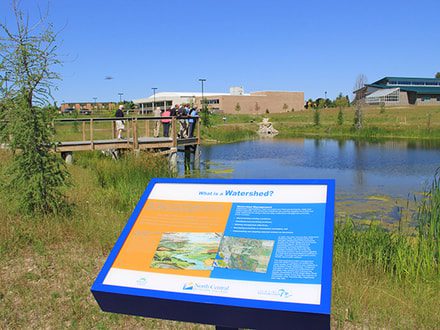
THE PROBLEM
- Campus stormwater was not being filtered properly causing excess nutrients and sediment from campus stormwater.
- Cattails had overgrown the wetland area rendering it ineffective
- Soil erosion and the loading of sediments, nutrients, and pollutants were entering the Bear River, and thus into Little Traverse Bay and Lake Michigan.
- The degradation of the stormwater wetland had limited the types of aquatic animals and insects.
THE RESULTS:
- Campus stormwater captured and treated
- Nutrients from campus stormwater absorbed by wetland before entering Bear River
- Sediments from campus stormwater filtered by wetland
- Volume of stormwater discharged to campus Natural Area and Russian Creek reduced and water quality improved
- Demonstration project established to promote green infrastructure and stormwater BMPs elsewhere within Little Traverse Bay Watershed.
- Soil erosion and the loading of sediments, nutrients, and pollutants into the Bear River, and thus into Little Traverse Bay and Lake Michigan, are significantly reduced. The activities proposed in this component aim to significantly reduce sediment flows into the Bear River and Little Traverse Bay.
- Nearshore Lake Michigan aquatic resources are protected by improving water quality in nearshore areas of Little Traverse Bay around the mouth of the Bear River.
This project was supported with funding through the Environmental Protection Agency’s Great Lakes Restoration Initiative
This short video highlights the stormwater wetland in action during a rainstorm. |

